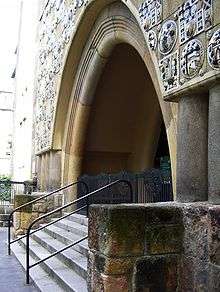Aladár Árkay

Aladár Árkay (Temesvár, February 1, 1868 - Budapest, February 2, 1932) was a Hungarian architect, craftsman, and painter.[1]
Career
Árkay gained his degree at the Budapest Technical University[1] where he studied under Ede Balló. Initially he worked in the firm of Fellner and Hellmer, then with Alajos Hauszmann in the works on Buda Castle. Later he formed a partnership with his father-in-law, Mor Kallina, and together they were responsible for the Directorate of Defence building in the Castle district (1896, since destroyed), the Buda Vigadó hall in Corvin Square (1896–97) and the St Gellért memorial on Gellért Hill (1904–05). Initially working in the eclectic style, as his career developed he worked in more modern forms such as secessionism and modernism. His first major independently completed work was the Babocsay villa, which later became the Yugoslav embassy, in district VI of Budapest (1905). He also worked on many church projects, the most significant of these being the Fasori Reformed Church in Budapest and the Győr factory district's Catholic church, both completed during the late 1920s. He took part and won numerous competitions such as that for the Győr theatre (1929) and the planning of Erzsébet avenue in the capital. He was in the process of planning his magnum opus, the Városmajor Catholic church in Budapest, when he died. It was finished by his son, Bertalan, also an architect.
Other works
- Bulgarian Orthodox Church, Ferencváros (Budapest)
- Catholic Memorial Church, Mohács
References
- 1 2 Árkay Aladár, Hungarian Electronic Library, retrieved 6 May 2012 (in Hungarian)
External links
![]() Media related to Aladár Árkay at Wikimedia Commons
Media related to Aladár Árkay at Wikimedia Commons